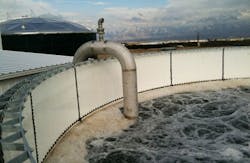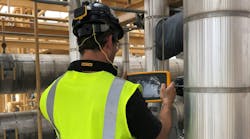By Chandler Johnson
Yet bringing TSA to bear in wastewater environments also entails a collaborative evaluation bent on better understanding facility needs. The resulting installation expertise best supports confirmation of design and selection of innovative product solutions that deliver good life-cycle cost and best water quality.
True TSA begins with this evaluation, which identifies options for achieving a company’s production goals. Development of a detailed engineering design in collaboration with facility engineers follows. Components and equipment are selected with an eye on durability and optimization. Overall system focus is on long-term reliability and consistent performance.
TSA also includes efficient installation, startup and training. Compliance is ensured by binding performance guarantees. Extended service plans make suppliers practically an adjunct to a company’s process-engineering team.
Components included in a TSA for industrial wastewater treatment vary depending upon the application. Two main categories include primary and secondary liquid/solid separation to remove particulates and organics and biological treatment of soluble biochemical oxygen demand (BOD) and ammonia. Related equipment may include pump stations, screening devices, sludge tanks and other ancillary equipment to handle any byproducts created.
TSA connotes customization and solutions tailored to users’ requirements. The examples outlined below involve different equipment and components, but each was initiated with the kind of in-depth evaluation discussed above as the means to an integrated, well-functioning solution.
Dannon case example
The first example involves upgrading of wastewater treatment at a Dannon yogurt manufacturing facility in Utah. The Dannon Co. is a well-known French food-products multinational corporation. Just two years prior, the facility installed a circular dissolved-air flotation (DAF) pretreatment system. It found, however, that the design wasn’t right for the application, leading to high operational costs from chemical consumption and poor performance.
Clearly, the plant wouldn’t be able to handle more wastewater coming from a planned facility expansion. It decided to construct a new wastewater treatment system. Dannon looked at several possible technologies, including anaerobic and aerobic solutions.
It chose a system that includes two rectangular high-rate DAF units, one for separation of suspended solids and fats, oils and greases; and one for separation of biological solids. The system handles pH swings without corrosion.
In addition, it selected moving-bed biofilm reactor (MBBR) technology for degradation of soluble organics. MBBR is a biological process used for BOD removal, nitrification and denitrification. Aside from the core DAF and MBBR technologies, the total system also includes rotary screening to remove debris and equalization to normalize the flow and load.
The system delivers significant advantages compared to alternatives. It has been successfully implemented at several dairies, which have widely variable wastewater loads.
To implement the turnkey project, Dannon partnered with MWH Engineering and World Water Works, which bore responsibility for the turnkey solution. This included the primary Ideal DAF and the Ideal MBBR-DAF and the slot-injector system for the EQ tank, as well as associated chemical feed equipment. The DAF-MBBR-DAF process is shown on Figure 1.
Within a few weeks the DAF units were operating at a fraction of the costs of the previous unit. The system can be expanded easily to meet further production needs. It is a flagship site for Dannon, and the plant has won awards at food-industry environmental conferences.
Packager pretreatment
TSA often reduces land, labor and operational costs compared to traditional approaches such as activated sludge. TSA is a good way to ensure a system actually meets permit effluent requirements.
Our second example is KanPak LLC, a family-owned company in Arkansas City, Kan., which develops aseptic packaging for beverages and desserts, including smoothies, coffee drinks, creamers, frozen desserts, cocktail mixes and specialty beverages.
The company is known for incorporating technology advances in aseptic processing and packaging, including stringent quality control. To meet discharge and pretreatment requirements at one of its manufacturing facilities, KanPak had installed a traditional biological wastewater treatment system, including a biological process and a secondary DAF. The system included an interceptor/pump station; equalization tanks; aerobic fixed-film bio treatment; secondary solids separation; DAF with flocculation tank; compressor/pressure tank; sludge dewatering; vertical rotary screw press; and a final effluent flow/pH monitoring.
Within a week of startup, the treatment process failed; solids would not floc and effluent was out of compliance. The plant was quickly overwhelmed by production discharge, as well as hot water as steam, sanitation products, floor foams, clean-in-place chemicals and sterilants. The design load was 2,800 lbs. /day of BOD5 but the actual load was 5,600-14,000 lbs. /day.
Given the situation, KanPak embarked on a TSA, based on a partnership between Fuss & O’Neil and WWW.
The evaluation determined that the wastewater equalization tank was not right for dairy wastewater. Dairy wastewater can go septic within hours if not properly handled, and the resultant odors and low pH were affecting downstream processes. It was also noted that combined sanitary wastewater was a safety issue for operators, as well as a solids issue. The system was not properly dewatering, which was causing poor sludge quality.
Finally, primary treatment was lacking. The high concentration of milk fat requires long hydraulic retention time for hydrolysis by bacteria and interferes with oxygen transfer.
Internal audit project
The evaluation also took note of a major in-plant resource-reduction initiative undertaken by KanPak. An internal audit identified excessive water use and the potential for reduction. The audit recommended batching system modifications, directing boiler blow-down to the publically owned treatment works (POTW) instead of the pretreatment system, closed-loop recirculation, conversion from retort to aseptic bottle line and directing sanitary wastewater to the POTW. The result reduced pretreatment system hydraulics from 400,000 to 100,000 gallons per day.
Based on the evaluation and source-reduction initiative, WWW developed a TSA for KanPak with improvements installed in phases over several years. The first phase eliminated odor, reduced sludge production through better solids dewatering characteristics and savings on chemicals, as well as better TSS and organics removal.
The second phase involved a pilot treatment study, followed by treatment plant design. The new system improved the EQ basin to prevent anaerobic conditions, installed a second DAF, replaced nitric acid for pH control with CO2, and upgraded the biological treatment with a new aeration system. The third phase improved dewatering — going from 4% to 18% solids — and significantly reduced sludge disposal costs.
The end result was improved sanitation with a marked reduction in water consumption, savings of more than $100,000 a year, a $4.5 million per-year savings in sludge disposal and chemical costs and a $1 million per-year savings in compliance costs.
Turkey processor pressure
Our final example of TSA benefits involves Sarah Lee/Hillshire Farms, which needed expanded wastewater facilities for its Iowa turkey-processing plant.
After evaluation, WWW suggested beginning with a DAF-EQ-DAF system and then further study to determine if biological treatment was needed at all. By doing so, the company had time to review the initial impact of change and to ask questions about what could be achieved with the effluent if additional treatment was added. This all took place over the course of about nine months.
The company added an MBBR to the treatment line, which reduced its BOD and TSS to single digits. Load reduction means its municipality now has significant additional capacity and will not have to expand its facilities.
Focusing on the total system is important. Too much focus on a single technology, piece of equipment or component may result in missing the bigger picture. And even if a company needs only to replace a single piece of equipment or component, the project elements should be included, with an emphasis on sound evaluation and the provision of solutions tailored to individual needs.
World Water Works, Inc. specializes in developing, designing and manufacturing highly efficient process and wastewater solutions. Solutions emphasize delivering clean water while recovering energy and other resources.



